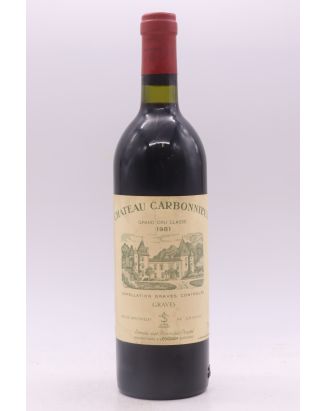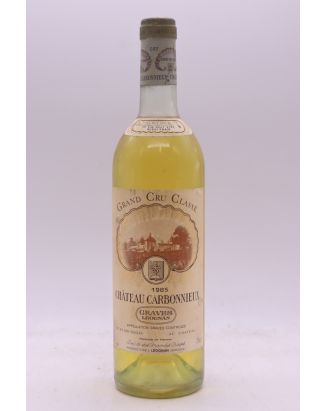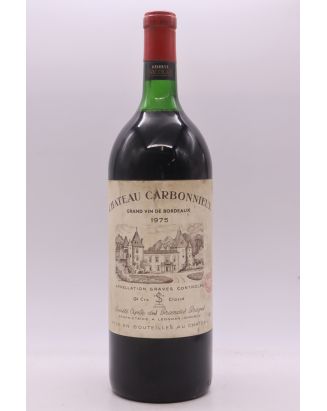










Château Carbonnieux has a rich and ancient history, dating back to the 12th century. Founded by Benedictine monks from the Sainte-Croix Abbey in Bordeaux, the estate has always been a place of wine production, particularly for wines intended for religious purposes. Its name comes from the Carbonnieu family, who owned the property in the 13th century.
The estate gained popularity in the 18th century, notably during the visit of Thomas Jefferson, future President of the United States, who praised the quality of the wines produced. At that time, the château's white wine was so renowned that it managed to be introduced to the court of the Sultan of Constantinople under the name "Carbonnieux mineral water", thus circumventing the Koranic law prohibiting the consumption of alcohol.
After the Second World War, the estate entered a period of decline until Marc Perrin acquired it in 1956. He then undertook a complete renovation of the vineyard and infrastructure. In 1959, Château Carbonnieux was classified as a Grand Cru de Graves, for both its white and red wines. Today, the estate is run by Éric and Philibert Perrin, who continue the work of their ancestors by perpetuating tradition while integrating modern innovations.
The terroir of Château Carbonnieux is a major asset for the quality of its wines. The estate spans 170 hectares, of which 100 are dedicated to vines, with an almost equal distribution between red and white grape varieties. The vineyard is planted on a ridge of Günzian and Pyrenean gravel, a soil formed by stony alluvium deposited by the Garonne during the Quaternary era. This soil, characteristic of the best terroirs of the Pessac-Léognan appellation, offers ideal conditions for vine cultivation, notably thanks to excellent natural drainage.
The 119 vineyard plots of Château Carbonnieux are carefully worked according to their specific characteristics. Each plot receives particular attention, with viticulture methods adapted to the unique pedological and ampelographic conditions. In terms of grape varieties, the estate respects a reasoned planting: Cabernet Sauvignon, Merlot, Cabernet Franc and Petit Verdot are reserved for predominantly gravelly plots, while white grape varieties such as Sauvignon Blanc and Sémillon thrive on clay-limestone soils.
Château Carbonnieux is also an estate committed to environmental preservation. It is certified High Environmental Value (HEV) and practises sustainable agriculture, banning chemical insecticides and herbicides in favour of ecological methods. Part of the vineyard is even following a conversion programme to organic farming.
The vinification process at Château Carbonnieux is a skilful blend of tradition and innovation. Each step is meticulously controlled to ensure wines of the highest quality, whether white or red.
White wine vinification
The white grapes are delicately harvested and hand-sorted to retain only the best berries. These are then pressed in state-of-the-art pneumatic presses, protected from oxygen, which preserves the aromatic freshness of the juices. The fermentation of white wines takes place in French oak barrels, which adds complexity and texture to the wine. The wines are aged for 10 months with regular bâtonnage, a traditional method that involves resuspending the lees to enrich the wine and give it "body" on the palate.
Red wine vinification
For red wines, after a rigorous selection of grapes, the bunches are destemmed and lightly crushed before being put into vats with their skins. Macerations last about 28 days at low temperature, in order to extract supple tannins and an intense colour. Once alcoholic fermentation is complete, the wine is put into barrels where it undergoes malolactic fermentation, thus reducing acidity and bringing roundness and complexity. Red wines are aged in oak barrels for 18 months, allowing the tannins from the wood to blend harmoniously with those of the wine.
Château Carbonnieux produces several emblematic cuvées, each reflecting the richness of its terroir and the expertise of the Perrin family.
Château Carbonnieux Rouge - Grand Cru Classé de Graves
This grand cru classé de Graves is a classic blend of Cabernet Sauvignon (50%), Merlot (40%), Cabernet Franc (5%) and Petit Verdot (5%). The red wine of Château Carbonnieux is distinguished by its freshness, silky tannins and complex aromatic palette, dominated by red fruits (blackcurrant, cherry) and toasted notes due to oak barrel ageing. This wine is ideal for ageing, developing deeper notes of truffle and graphite over the years.
Château Carbonnieux Blanc - Grand Cru Classé de Graves
The white wine of Château Carbonnieux, also a grand cru classé, is mainly composed of Sauvignon Blanc (68%) and Sémillon (30%). It charms with its freshness and aromatic intensity, blending notes of citrus, white flowers and exotic fruits. With time, it evolves towards aromas of dried fruits and honey, thus offering numerous possibilities for gastronomic pairings.
La Croix de Carbonnieux
This second wine of the estate is produced from the same plots as the cru classé, but the vines used are younger. La Croix de Carbonnieux red is a gourmet, fruity wine, more accessible in its youth, while La Croix de Carbonnieux white offers a beautiful aromatic expression, full of freshness and vivacity.
Château Tour Léognan
Produced from the estate's young vines, Château Tour Léognan is an elegant wine that is pleasant to drink in its youth. It benefits from the same care in cultivation and vinification as its elders, but is distinguished by its immediate accessibility and gourmet aromas.
The vintages of Graves and Pessac-Léognan, two Bordeaux appellations, stand out for their consistent quality. The years 1975, 1982, 1983, 1985, 1986, 1988, 1989 and 1990 are particularly prized for their finesse and balance. The vintages 1998, 2000, 2005, 2008, 2009 and 2010 are equally remarkable for their structure and ageing potential. More recently, the vintages 2012, 2014, 2015, 2016, 2017, 2018, 2019 and 2020 confirm this continuing excellence, with wines offering both elegance and longevity.
Explore all the Grands Crus Classés de Graves, an appellation renowned for the diversity and quality of its wines. At the top of the list, the First Growth of 1855, Château Haut-Brion of Pessac-Léognan, is a historical reference. For red andwhite wines, estates such as Château Bouscaut, Château Carbonnieux, Château Malartic-Lagravière, Château Olivier, Château Latour-Martillac and Domaine de Chevalier offer interesting cuvées. For reds, you can discover the wines of Château Fieuzal, Château Haut-Bailly, Château Latour Haut-Brion, Château La Mission Haut-Brion, Château Pape-Clément and Château Smith-Haut-Lafitte. White wine enthusiasts can turn to the productions of Château Couhins, Château Couhins Lurton and Château Laville Haut-Brion. These estates offer you a wide range of wines to discover in the heart of the Graves region.
Château Carbonnieux, with its grand crus classés and exceptional cuvées, embodies the excellence of the Bordeaux vineyard. Thanks to a unique terroir, an environmentally respectful approach and ancestral know-how, this estate produces wines that combine finesse, complexity and ageing potential. Whether you are a fan of powerful red wines or fresh and aromatic white wines, the wines of Château Carbonnieux deserve a place in your cellar, and promise to enhance your meals with elegance.